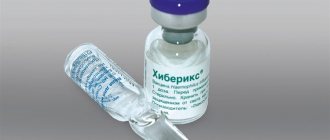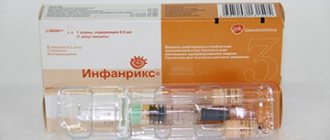H. influenzae b infection
The causative agent of Haemophilus influenzae is the bacterium Haemophilus influenzae (or Pfeiffer's bacillus) from the Pasteurellaceae (Hib) family. For a long time, hemophilas were considered the causative agent of influenza, since this infection most often occurs in the form of nasopharyngitis or acute respiratory infections without specific features, which led to its name. The bacterium is a small polymorphic rod, sometimes resembling a coccobacilli in shape. No doubt, it has a capsule. Cultivation requires blood, special additives and vitamins. Depending on the differences in the chemical structure and antigenic properties of the capsule, 6 serotypes of H. influenzae are distinguished (serotypes a, b, c, d, e, f), as well as non-capsular strains.
Infection with Haemophilus influenzae rarely leads to disease, but the spectrum of infectious lesions can be extremely wide and depends on the serotype of the pathogen. In adults, H. influenzae causes predominantly focal bronchopneumonia, often combined with severe tracheobronchitis. Pneumonia rarely becomes severe, but in some cases it can be complicated by exudative pleurisy, pericarditis, meningitis, arthritis, etc. Haemophilas are part of the normal flora of the upper respiratory tract; the level of asymptomatic carriage in children reaches more than 40%.
H.influenzae type b (Hib) has the most pathogenic properties and the ability to cause severe forms of the disease. Its virulent properties are associated mainly with the capsular polysaccharide and the production of membranotoxin.
In invasive forms of the disease, the pathogen is detected in sterile body fluids - CSF, blood, pleural fluid, etc. Non-invasive forms of infection include pneumonia (without bacteremia), sinusitis, otitis media, nasopharyngitis, conjunctivitis. With the generalization of the infectious process, invasive forms of infection develop, the most common manifestation of which is meningitis (51–65%), septicemia - 12%, epiglottitis - 10%, pneumonia (with bacteremia) - 8% in the structure of invasive Hib infections.
Children aged 6–48 months are most often susceptible to Hib infection, and less frequently, newborns and children over 5 years of age. The vast majority of cases occur between the ages of 3 months and 3 years.
Risk factors are:
- visiting organized children's groups (nurseries, kindergartens), especially closed ones (orphanages, boarding schools);
- artificial feeding;
- immunodeficiencies (primary and secondary, including HIV infection);
- chronic diseases (heart, lungs, diabetes).
The spread of infection occurs through airborne droplets or household transmission. In more rare cases - during childbirth, from a mother with Haemophilus influenzae colonization of the genital tract.
The source and main reservoir of infection is only humans. On average, among healthy children, bacteria carriers make up 2–5%, but in the environment of a sick person their proportion can increase to 30% or higher. Reducing the frequency of carriage helps reduce the incidence rate. In countries where vaccination against Hib infection has been introduced, the proportion of carriers in the population of healthy children has decreased to 0.5–1%.
Indications for examination
- Studies for epidemiological indications - among contact persons in the focus of Hib infection (most often Hib meningitis);
- preventive studies - in order to identify the level of carriage in the population, especially in closed children's groups;
- diagnostic studies - if there is a suspicion of epiglottitis, pneumonia, meningitis, septicemia, otitis, sinusitis, purulent arthritis, osteomyelitis.
Material for research
- Sputum, lavage fluid, punctates (if pneumonia is suspected); purulent discharge, punctates; (otitis media, sinusitis); CSF, blood; (meningitis, menigoencephalitis); blood (septic conditions); punctates (purulent arthritis, osteomyelitis); sectional material; throat smear (examination of contacts at the site of Hib meningitis and carrying out preventive studies) - cultural studies;
- CSF, blood, punctures – detection of DNA fragments;
- CSF, blood – detection of hypertension.
Etiological laboratory diagnosis includes
microscopy of the studied material, seeding of the material with further cultural and biochemical identification of the pathogen, determination of antibiotic sensitivity; detection of genetic fragments of Hib DNA and Hib Ags in sterile body fluids.
Differential diagnosis
carried out with microbial agents:
- For epiglottitis - with pathogens causing true and false croup (C.diphtheriae, S.pyogenes, various viruses);
- for meningitis - with pathogens that cause purulent meningitis (N.meningitidis, S.pneumoniae, S.aureus, etc.);
- for pneumonia – S.pneumoniae, C.pneumoniae, M.pneumoniae, L.pneumophila, S.aureus, Enterobacteriaceae family, influenza viruses;
- for otitis and sinusitis – S.pneumoniae, Ps.aeruginosa, S.aureus, M.catarrhalis, S.pyogenes, yeast fungi of the genus Candida;
- for purulent arthritis, osteomyelitis – S.aureus, E.coli, anaerobic infection.
Comparative characteristics of laboratory diagnostic methods.
Microscopic examinations are used to detect Haemophilus influenzae in different types of biological material: cerebrospinal fluid, blood, punctates of sterile loci, punctates of non-sterile loci (sputum, smears from the throat, paranasal sinuses, ear, etc.). Microscopy, as an independent study, is usually not performed, as it has little diagnostic value. Microscopic examination can only be used to decide the suitability of sputum or lavage fluid for culture (the smear must contain more than 25 segmented leukocytes and less than 10 epithelial cells in the field of view), as well as to determine microbial associations.
For inoculation with further cultural and biochemical identification of the pathogen, determination of antibiotic sensitivity, materials from sterile loci (blood, cerebrospinal fluid, synovial, pericardial, pleural fluid) and various material from non-sterile loci are used.
An important problem for the treatment of Hib infection is the increase in resistance to β-lactam antibiotics, primarily ampicillin, caused by the production of plasmid β-lactamases. In addition, there is an increase in resistance to gentamicin, erythromycin, and chloramphenicol in the world.
When determining the sensitivity to antibiotics of a culture isolated from non-sterile loci, resistance to ampicillin, ampicillin/sulbactam, and co-trimoxazole is first examined. It is advisable to test for β-lactamase production with nitrocefin. As additional drugs to characterize the strain, the study includes II–III generation cephalosporins, tetracyclines, macrolides, chloramphenicol, and fluoroquinolones.
Strains isolated from cerebrospinal fluid and blood are tested for sensitivity to ampicillin, third-generation cephalosporins, carbapenems, chloramphenicol; other drugs (tetracyclines, macrolides, fluoroquinolones) are added for a more complete characterization of the culture.
Detection of Hib Ag in sterile body fluids (cerebrospinal fluid, blood) is performed using reagent kits based on latex agglutination or coagglutination reactions.
Detection of Hib DNA fragments is carried out by PCR. The study is based on the detection of a specific fragment of the bex A gene, encoding the pathogen protein associated with the capsule and is carried out only with material obtained from sterile loci (CSF, blood, punctates)
Features of interpretation of laboratory research results.
The diagnosis of Hib infection is considered established in the following cases:
- isolation of bacteria H.influenzae type b from biomaterial samples;
- identifying bacteria similar in morphology to Haemophilus influenzae (polymorphic gram-negative rods) in biomaterial samples taken from sterile loci and obtaining a positive result for identifying AG in the latex agglutination reaction used to detect AG;
- detection of specific Hib DNA fragments by PCR in biomaterial samples taken from sterile loci.
Haemophilus (hemophilus)
Hemophilus
(
Haemophilus
) is a genus of gram-negative bacteria.
Haemophilus
are small rod-shaped and motionless.
Many Haemophilus
are commensals in the human body.
Haemophilus
is found in the stomach of healthy people (provided that
Helicobacter pylori
) (Engstrand L., 2012).
Haemophilus bacteria are pathogens of human diseases
| Chancroid. Pathogen Haemophilus ducreyi |
Some Haemophilus
cause serious human disease.
In particular, Haemophilus influenzae
, also called Haemophilus influenzae or Pfeiffer (or Pfeiffer) bacillus, is the causative agent of so-called human hemophilic infections, including purulent meningitis, acute pneumonia, septicemia, inflammation of the epiglottis, purulent artitis, pericarditis, sinusitis, otitis and other respiratory diseases ways.
Haemophilus ducreyi
is the causative agent of a venereal disease - chancre.
| Brain with meningitis caused by Haemophilus influenzae |
In rare cases, Haemophilus parainfluenzae,
which is part of the normal human microflora, can cause opportunistic infections, in particular endocarditis in children.
Haemophilus aegyptius
(Koch-Wicks bacillus) is the causative agent of Brazilian purple fever (ICD-10 code A48.4), conjunctivitis in children under 10 years of age, which without treatment develops into a dangerous systemic disease.
Haemophilus spp.
.
isolated in irritable bowel syndrome (IBS) with diarrhea, esophagitis, Barrett's esophagus, bronchial asthma; Haemophilus influenzae
– for pneumonia, sinusitis, meningitis, otitis, arthritis (Kapreeva Yu.S. et al.).
HACEK Group
A number of species of the genus Haemophilus
, in particular,
Haemophilus parainfluenzae, Haemophilus aphrophilus, Haemophilus paraphrophilus
and some others, as well as bacteria of other genera:
Aggregatibacter actinomycetemcomitans, Cardiobacterium hominis, Eikenella corrodens
and
Kingella kingae
form the so-called HACEK group. These are gram-negative, difficult-to-cultivate, slow-growing microorganisms that are part of the normal microflora of the human oral cavity and require an atmosphere saturated with carbon dioxide to function. HACEK bacteria are associated with approximately 5-10% of cases of local endocarditis in patients not using intravenous drugs. In addition to infective endocarditis, bacteria in this group cause wound infections (particularly from bites), soft tissue abscess, brain abscess, endophthalmitis, mumps, periodontitis, empyema and bacteremia without endocarditis and osteomyelitis. In addition, associated rare cases of endometritis and urinary tract infections have been identified.
Haemophilus in the taxonomy of bacteria
The genus Haemophilus
is included in the family
Pasteurellaceae
, order
Pasteurellales
, class Gamma-proteobacteria (Latin
γ proteobacteria
), phylum Proteobacteria (Latin
Proteobacteria
), kingdom Bacteria.
In the genus Haemophilus
includes the following species:
Haemophilus aegyptius
(Koch-Wicks stick)
, [Haemophilus] ducreyi
(Ducrey stick)
, Haemophilus haemoglobinophilus, Haemophilus haemolyticus, Haemophilus influenzae
(Pfeiffer stick)
, Haemophilus influenzae-murium, Haemophilus massiliensis, Haemophilus paracuniculus, Haemophilus paraha emolyticus, Haemophilus parainfluenzae, Haemophilus paraphrohaemolyticus, [Haemophilus] parasuis, Haemophilus pittmaniae, Haemophilus quentini, Haemophilus simiae, Haemophilus sputorum, Haemophilus taxon C, Haemophilus genomosp.
P1 .
As part of the species Haemophilus influenzae
allocated to a separate <group without rank>
Haemophilus influenzae biotype aegyptius
.
Previously, the genus Haemophilus
included, in particular, the following species:
- Haemophilus vaginali
s, now transferred to the genus
Gardnerella
and called
Gardnerella vaginalis - Haemophilus actinomycetemcomitans
, transferred to the genus
Aggregatibacter
and called
Aggregatibacter actinomycetemcomitan
Vaccines and antimicrobial agents active against Haemophilus
The following antibiotics (from those presented in this guide) are active against Haemophilus
:
- ciprofloxacin - active against Haemophilus spp.
- clarithromycin and azithromycin - active against H. influenzae, H. parainfluenzae
and
H. ducreyi - norfloxacin - active against H. ducreyi, H. influenzae, H. aegyptius
- levofloxacin and moxifloxacin - H. influenzae, H. parainfluenzae
- doxycycline and tetracycline - H. ducreyi, H. influenzae
- amoxicillin - H. influenzae
- josamycin - H. influenzae
- rifabutin - H. influenzae
In the Anatomical Therapeutic Chemical Classification (ATC), in the section “J07 Vaccines” there is a separate section “J07AG Vaccines against Haemophilus influenza
B”.
In Russia, three vaccine preparations are approved for use for the prevention of diseases caused by Haemophilus influenzae
type b: Hiberix (English:
Hibe rix
), Act-HIB (English: Act-HIB) and “Hemophilus influenzae type b conjugate vaccine” (produced by the Rostov Research Institute of Microbiology and parasitology).
Instructions from the manufacturer of the vaccine against Haemophilus influenzae
US type
b
On the website GastroScan.ru in the “Literature” section there is a subsection “Microflora, microbiocenosis, dysbiosis (dysbacteriosis)”, containing articles addressing the problems of microbiocenosis and dysbiosis of the human gastrointestinal tract.
Back to section
Haemophilus influenzae, DNA of Haemophilus spp.
Haemophilus influenzae, Haemophilus spp. DNA, quality
— determination of Haemophilus influenzae (Haemophilus spp.) DNA in a scraping using the polymerase chain reaction (PCR) method with real-time detection.
The PCR method
allows you to identify the desired section of genetic material in a biological material and detect single molecules of microorganism DNA that are not detected by other methods. The principle of the method is based on a multiple increase in the number of copies of DNA sections specific to a given pathogen.
Using PCR analysis, it is possible to diagnose infection in the acute period and identify cases of carriage.
Haemophilus influenzae
(Haemophilus spp.)
The source of infection is a sick person (carrier).
The main route of transmission of infection is airborne droplets.
Influenza bacillus infection can be diagnosed in patients of different ages, but most often it can be observed in preschool children under 4 years of age. Mortality is recorded in approximately 10% of cases. In this regard, it is extremely necessary to consult a specialist in a timely manner, take tests and carry out appropriate therapy.
In children, Haemophilus influenzae is one of the main causes of childhood meningitis. Meningitis caused by this bacillus in children aged 1 to 2 years is severe, with progressive stupor and coma. Mortality can reach from 50 to 75% of cases. The susceptibility of people to infection is quite high and a pronounced dependence of the incidence of immunodeficiency is found. Widespread carriage of this bacillus in the upper respiratory tract among the population has been revealed, which can reach 90% among healthy individuals.
The study of Haemofilus influenza using the PCR method is carried out in the department of molecular genetic research of the DNAOM scientific center. Its main advantage is that it is a direct research method. During the polymerase chain reaction, in case of a positive result, genetic material is detected - Haemophilus influenzae DNA in the sample.
Indications
An analysis for Hemophilus influenzae should be prescribed if an acute airborne infection is suspected, as well as for the following inflammatory diseases:
- meningitis;
- otitis media;
- sinusitis;
- pneumonia;
- conjunctivitis;
- purulent arthritis;
- acute epiglottitis (inflammation of the epiglottis);
- osteomyelitis (damage to the bone marrow);
- septicemia (blood infection);
- mastoiditis (complication of purulent otitis).
Preparation
One month before the test, you must avoid taking antibiotics.
Men:
- urethral scraping.
It is recommended to take the test 2 hours after the last urination; - the first amount of freely released urine.
Women:
- scraping of the urethra, cervical canal, vagina
. Submitting scrapings is not allowed on menstrual days. Three days before the collection, you must stop using vaginal suppositories, tampons, spermicides, and a day before, avoid sexual intercourse. You should not douche on the eve of the examination. After an ultrasound examination using a vaginal sensor, colposcopy, biopsy, at least 48 hours must pass.
Interpretation of results
The answer is given in a qualitative format: “detected” or “not detected”
Normally, no pathogen DNA is detected.





